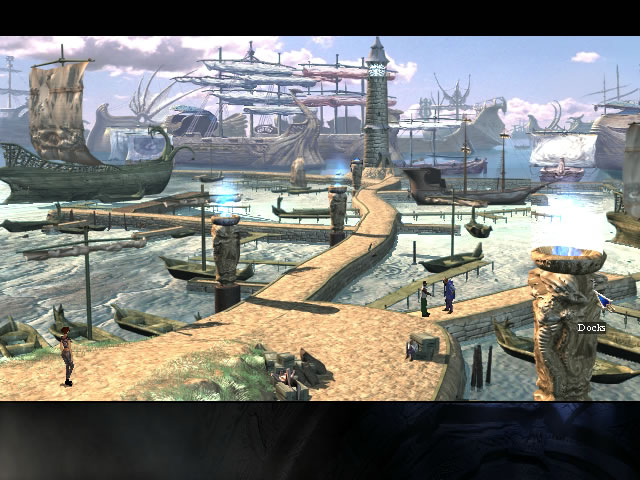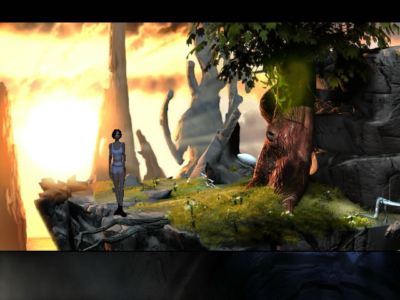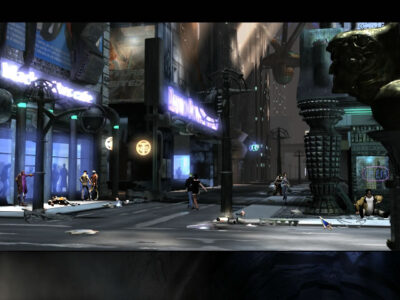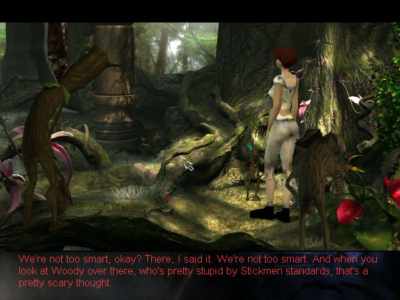
The Longest Journey
Written by: Stoo
Date posted: February 10, 2008
- Genre: Adventure
- Developed by: Funcom
- Published by: Empire Interactive Entertainment
- Year released: 2000
- Our score: 7
Adventure games aren’t quite dead, in case anyone was wondering. Just check out the rather awesome new Sam and Max series. However, the heyday of the classic “point-and-clicker” as a high-profile mainstay of gaming is over. In fact, it was already over eight years ago. The Sierra studios, which had produced so many “quests” over the years had shut down, and Lucasarts would that year release their last adventure to date. Maybe adventures were no longer financially viable, maybe the coming of 3D action gaming killed them off, I’m not sure. Maybe one day we should research and write an article about the rise, peak and fading of the adventure – by which I mean “Rik does all the hard work reading old magazines and playing quests until his eyes glaze over, Stoo shamefully spends a week playing World of Warcraft”. Anyway with the big names having closed or lost interest, it was up to other smaller studios to do their best to keep the adventure going. So here’s a 2000 offering, created by Norwegian studio Funcom.
The Longest Journey is the story of April Ryan, an 18 year old girl living in the city of Newport in the year 2200ish. She’s just student going about a quiet unassuming life, hoping to one day be an artist. As events unfold, however, she learns there are in fact two parallel earths out there. Her (and our) own world is Stark, a futuristic land of logic and science. Alongside it is Arcadia, a fantasy land of magic. For millennia the two have existed in a carefully maintained balance, watched over by guardians, but now that balance is threatened. Of course, April learns she has an important part to play in putting things right.
Before such grand events start happening, though, the game gets off to a fairly dull start. Well, the very beginning is a dream where April talks to a tree in her underwear, which might look like a cheap attempt to target the young male demographic. However most of the first chapter is just her everyday normal routine. Although much of Newport is supposed to be a grim and blade-runner-ish place, the area she lives in is a former industrial zone turned into a hub for students. So she attends an art college, rents a room in a house owned by a lesbian couple who swear a lot, and her best friend is a guy who works in a bar and dreams of being a professional dancer. Which isn’t quite so typical male demographic material. Activities in that first chapter include digging out her pay slip, and having deep soulful conversations with her friends about what they mean to each other. The plot then kicks in when some rambly Spanish guy bombards Ryan with mystical-sounding blather, her response being to brush him off but actually be intrigued at the same time.
If at this point if you’re thinking you’d prefer Guybrush meeting pirates or Ben the biker kicking a dumpster, I don’t blame you. Still, the narrative is doing its part here to establish April’s character. I guess her own personal “journey” can’t mean a lot if we can’t appreciate where she’s starting from – a girl with practical problems paying the rent getting her assignment done, who’s initially highly sceptical of rambly Spanish guy and his talk of destiny.
From here the story perks up a bit, although it’s structured around a rather uninspiring hunt for bits of magical talisman. Which is really more something I’d expect in a dungeon-hack RPG than an engrossing adventure story. The parallel worlds idea is something that can come to life, with some inspired writing, but it needs something more rousing to it than a magic trinket hunt. Also, it feels underdeveloped in places. A bunch of mysterious “dark people” appear from nowhere and then drop out again without you ever doing much to interact with them. Also the supposed “dear friends” of April are largely tossed aside and ignored in the later stages, whilst new characters are brought in as major players, without proper effort being made to establish them and make you give a damn what they do.
Fortunately though, the experience is rescued by the peoples and places you discover along the way, and the personal touches they bring. Arcadia might sound rather twee, a land of the “magic peoples”, but there were some characters I genuinely warmed to. There’s a lumpy-looking chap who perceives time differently to us and has problems with his tenses, a rambling old sailor who patently doesn’t have a clue what he’s on about, and grumpy guys made of sticks. One of my top moments in the game was trying to waken a sleepy, sad giant with the “help” of the stick guys; it’s silly on some level, but also fun. Most important is Crow, who becomes a trusted sidekick and manages to tread the fine line between snappy lines and annoying.
Be warned though, there’s a lot of talking along the way, if that sort of thing bothers you . Myself I’m happy enough with conversations with some of the colourful characters. However, when it comes to important Plot Stuff it can mean listening to Spanish guy whitter on, or some old priest subjecting you to exposition dumps along the way. “Show, not tell” isn’t really a theme when it comes to major plot points. They’re happy to tell, at great length. Fortunately the voice acting is of a good enough standard, most of the time. I say “fortunately” especially so as the English version is a localisation, which you might expect to be done on the cheap. However several of the characters come alive quite convincingly, if a little hammily sometimes, and only a few sound like a bored guy from accounts being roped in.
Anyway the tone isn’t exactly deadly serious throughout. Oh, the core plot is quite earnest talk of balance between the worlds, and guardians, and the power-hungry forces threatening all that. But there’s a more light-hearted feel to a lot of the situations you find April in. At one point she challenges an evil wizard to playing little games, in another back on Stark she’s sneaking into a police station for information and generally pissing around irritating a detective. That’s a bit incongruous, since this is meant to be a grim future city ruled by soulless corporations, where ominous armoured cops wave guns at kids for skateboarding and probably make people “disappear” quite easily. On a related note, I’m still unsure as to how much I actually like April Ryan. She seems to breeze through all these situations with an attitude of “oh wow I can’t believe I did that!!”, then onto something else. “Looks like I’ve got to find the mad alchemist and stop him, yikes!”. I can’t help feeling the events that transpire should have a little more of an impact on her. Still with her whimsical nature she’s not outright unlikeable or devoid of personality.
As for puzzles you’ll encounter, they aren’t the most taxing. The trickiest are probably nearer the start and, er, I ran like a wimp to gamefaqs once or twice. My excuse is that I was in a hurry, honest, masses of oldies to get through, and I bet they won’t greatly trouble anyone who made it through Discworld. Later on, well, often they’re dead simple. If anything, I was more often confused by being in a situation with several major long-term goals but no immediate apparent actions to take. In this case it’s just a matter of going around and talking to people until something presents itself. Again though, it’s not like I was stumped for long.
On the graphical side, The Longest Journey eschews the cartoony look as seen in Broken Sword and represents a move to more modern technology. The environments are pre-rendered, and all quite pleasing to the eye. Newport is grimy and neon-lit in, but with more a theme of canals and cast iron in April’s home area. In Arcadia meanwhile it’s is a joy to explore places like tropical islands and forests – it fits the fairly relaxed nature of the game to just stroll about and take in the sights. Characters meanwhile are true 3D models, which I have mixed feelings about. Animation isn’t fantastic, also, there’s no implementation of facial expressions. So while in some ways the visuals are an improvement on older games, in terms of characters’ capacity to display emotion it does feel like a step backwards. So the voice acting has to do most of the work by itself. Oh, and the pre-rendered cut scenes are unimpressive, with April looking downright ugly.
I started this adventure quietly yawning to myself, but came away from it liking it more than I initially thought I would. It has some ambition, which I respect. Where many adventures went for wacky humour, or sierra-style twee fairtales, The Longest Journey wants to tell us a sweeping, moving fantasy story. It wants us to become become engrossed in the narrative, and feel sadness and joy along with the protagonist. In the end, it’s not always completely successful. Still it does make more of an effort than many games do, to provide a genuinely compelling story-driven experience. Overall I did become quite caught up in April’s tale – enough so that I plan on playing the sequel to see what happens next, and I look forward to revisiting Arcadia and Stark.





 Posts
Posts